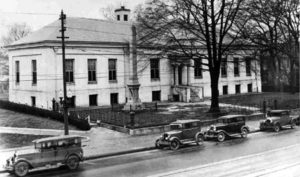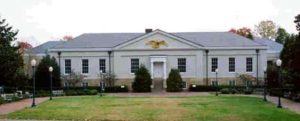
The U. S. Mint at its original location

The U. S. Mint on the grounds of the Mint Museum of Art in Eastover
| Survey and Research Report on United States Mint – Charlotte Branch
by Paula M. Stathakis Note: The original location of what is now known as the Mint Museum was 403 West Trade Street, Charlotte, N.C. The oldest building of the Mint Museum complex, the Strickland Building, was originally a branch of the United States Mint. This building became endangered in 1931 when Mecklenburg County decided to expand the adjacent Main Post Office. Charlotte architect Martin Evans Boyer Jr. tried to save the structure through a series of designs which would have accommodated the expansion of the Post Office while allowing the Mint to remain on its original site. Boyer corresponded regularly with his friend Herschel V. Johnson, then Chief of the Mexican Division of the U.S. State Department. Johnson provided Boyer with contacts in the departments of the Federal Government to whom to submit his plans to allow both the expansion of the Post Office and the preservation of the Mint. Boyer had the support of a number of prominent citizens, including Senator Cameron Morrison, Stuart W. Cramer, E. E. Jones (Vice-President of Independence Trust Company), and one of the most influential architects in the South, Earle Sumner Draper. 1 Boyer’s efforts to preserve the Mint Building on site were unsuccessful. A letter from the Assistant Secretary of the Treasury to Charlotte Mayor Charles Lambeth stated that his department had received several letters in favor of plans to accommodate the Post Office expansion with the preservation of the Mint. However, the Treasury had decided that there was no alternative but to demolish the Mint in order to enlarge the Post Office. His letter suggested that if anyone wanted to arrange for the Mint to be moved to another site at no expense to the government, the Treasury Department would have no objection. The Assistant Secretary advised that any plan to move the structure be carried out quickly. 2 In 1933 the Mint was dismantled for a sum of $950 and moved to a site in the Eastover neighborhood donated by E. C. Griffith. 3 The structure was used as a Museum and held its inaugural exhibit in 1936. Much of the early activity of the Museum staff was devoted to acquiring art for display. There is evidence that the grounds around the building were developed and maintained by the dedicated efforts of Mrs. Phil MacMahon, who chaired the Grounds Committee, and Mrs. E. P. Coles, who was in charge of the Green Gardens. 4 The grounds were not formally landscaped until 1955. Landscape architect Stuart Ortloff of the firm of Ortloff-Raymore of Huntington, New York was commissioned by the Charlotte Garden Club to do the work. The Club, organized in 1924, first became affiliated with the Mint Museum in 1954, and the relationship continues. 5 Ortloff’s plan included brick walkways surrounding an open lawn. The walks were lined with pink and white Japanese flowering cherry trees, then rows of evergreen magnolias. A row of Norway maples buffered the lawn from two side streets. In front of the building were planted two Burford hollies on each side of the front steps. Extending from the English hollies on each side were laurels, camellias, and broad-leafed Japanese hollies. English ivy and azaleas were planted close to the walls of the entire front facade. 6 Benches made of teak and iron, imported from England, completed the plan. Notes1 Martin Evans Boyer Jr. Papers, Special Collections, UNCC, Box 1. 2Ibid. 3 Ibid. 4 Ibid., a booklet entitled “Inaugural Exhibition of the Mint Museum of Art, October 1, 1936-January 1, 1937.” 5 Phil Blusher, “Garden Club Roots Run Deep,” Member News (of the Mint Museum of Art), Nov.-Dec. 1989, no pagination. 6 A copy of Ortloff’s plan was generously provided by Benjamin Pearce, current president of the Charlotte Garden Club. This blueprint is attached. The original location of what is now known as the Mint Museum was 403 West Trade Street, Charlotte, N.C. |
|
|
||||
